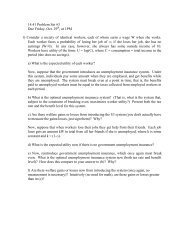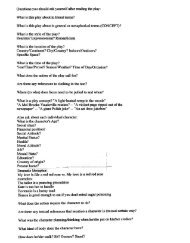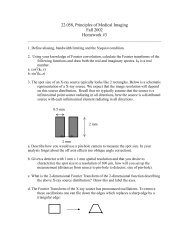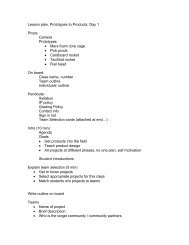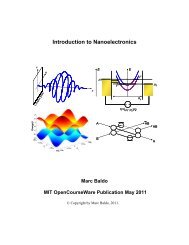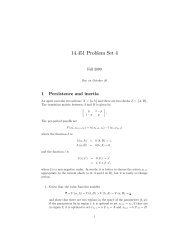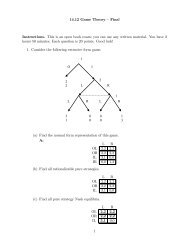8.323 Relativistic Quantum Field Theory I
8.323 Relativistic Quantum Field Theory I - MIT OpenCourseWare
8.323 Relativistic Quantum Field Theory I - MIT OpenCourseWare
You also want an ePaper? Increase the reach of your titles
YUMPU automatically turns print PDFs into web optimized ePapers that Google loves.
MIT OpenCourseWare<br />
http://ocw.mit.edu<br />
<strong>8.323</strong> <strong>Relativistic</strong> <strong>Quantum</strong> <strong>Field</strong> <strong>Theory</strong> I<br />
Spring 2008 <br />
For information about citing these materials or our Terms of Use, visit: http://ocw.mit.edu/terms.
MASSACHUSETTS INSTITUTE OF TECHNOLOGY<br />
Physics Department<br />
<strong>8.323</strong>: <strong>Relativistic</strong> <strong>Quantum</strong> <strong>Field</strong> <strong>Theory</strong> I<br />
Prof.Alan Guth February 16, 2008<br />
PROBLEM SET 2<br />
REFERENCES: Peskin and Schroeder, Section 2.3 and part of 2.4, through p. 29. Also<br />
Lecture Notes 1 (or Lecture Slides 1): Quantization of the Free Scalar <strong>Field</strong>.<br />
Problem 1: Complex scalar fields (10 points)<br />
Peskin and Schroeder, Problem 2.2. The problem as stated in the original printing<br />
asked you to find 4 conserved currents for the theory with two complex scalar fields.<br />
There are actually 6 conserved currents, as is indicated on the Peskin and Schroeder<br />
corrections web page,<br />
http://www.slac.stanford.edu/∼mpeskin/QFT.html<br />
and in the newer printings of the book.You will get full credit for finding the same four<br />
that Peskin and Schroeder found, and their generalization for n fields.If you can find all<br />
six currents for two fields and their generalization for n fields, you will get extra credit,<br />
for a maximum of 12 points.<br />
Problem 2: Lorentz transformations and Noether’s theorem for scalar fields<br />
(continued) (10 points)<br />
In Problem 4 of Problem Set 1, you showed that the Lorentz invariance of the theory<br />
of a single scalar field leads to a conserved current (∂ µ j µλσ = 0)thatcan be written as<br />
where<br />
j µλσ = x λ T µσ − x σ T µλ ,<br />
T µν = ∂ µ φ∂ ν φ − η µν .<br />
The conserved quantities are then<br />
<br />
M λσ ≡ d 3 xj 0λσ .<br />
Express these conserved quantities in terms of creation and annihilation operators.[Hint:<br />
For the case where λ and σ are both spacelike, the conserved quantity can be written as<br />
M ij ≡ ɛ ijk J k ,<br />
where ɛ ijk is the fully antisymmetric Levi-Civita tensor.One then finds that<br />
<br />
J i d 3<br />
= −iɛ ijk<br />
(2πp<br />
) 3 pj a † (⃗p) ∂a (⃗p )<br />
∂pk .<br />
In the course of the derivation you will find ill-defined c-number contributions.You should<br />
verify the above expression for J i , arguing that the c-number contributions vanish due<br />
to a symmetry argument.You should also calculate the answer for the case where λ = 0,<br />
σ = i.]
<strong>8.323</strong> PROBLEM SET 2, SPRING 2008 p. 2<br />
Problem 3: Lorentz transformations and Noether’s theorem for the electromagetic<br />
potential A µ (x) (10 points)<br />
Consider again the electromagnetic potential A µ (x), as discussed in problem 2.1 of<br />
Peskin and Schroeder.The Lagrangian is<br />
=<br />
1 µν<br />
− F µν F , (1)<br />
4<br />
where<br />
F µν = ∂ µ A ν − ∂ ν A µ . (2)<br />
In problem 2.1 we learned that translation invariance and Noether’s theorem lead to<br />
a nonsymmetric energy-momentum tensor, which can be made symmetric by adding a<br />
piece that has the form of a total derivative that is automatically conserved regardless<br />
of the equations of motion.We discussed in lecture, however, how the conservation of<br />
angular momentum forces one to use a symmetric energy-momentum tensor, so that the<br />
cross product of ⃗r and the momentum density T 0i gives a conserved angular momentum<br />
density<br />
<br />
j 0k<br />
i = ɛ ijk x T . (3)<br />
If T µν is both conserved and symmetric, then this angular momentum density can be<br />
written as the 0th component of the divergenceless current<br />
K µλσ = x λ T µσ − x σ T µλ , (4)<br />
where<br />
∂ µ K µλσ =0 and i = ɛ ijk K 0jk . (5)<br />
One might hope, therefore, that if one derived the conservation of angular momentum<br />
by using rotational symmetry and Noether’s theorem, then one would be led directly to<br />
a symmetric energy-momentum tensor.This hope, however, is not realized, as will be<br />
shown in this problem.<br />
We are interested mainly in rotations, but for the sake of generality we will consider<br />
arbitrary Lorentz transformations, which include rotations as a special case.Since A µ (x)<br />
is a Lorentz vector, under a Lorentz transformation x ′µ =Λ µ ν x ν it transforms as<br />
A ′µ (x ′ )=Λ µ ν A ν (x) . (6)<br />
For an infinitesimal Lorentz transformation Λ µ ν = δ ν<br />
µ<br />
−Σ µ ν , where Σ µν is antisymmetric<br />
as discussed in the previous problem, the symmetry tranformation becomes<br />
A ′µ (x) = A µ (x)+Σ λσ<br />
<br />
x<br />
σ<br />
∂ λ A µ (x) − η µλ A σ (x) . (7)
<strong>8.323</strong> PROBLEM SET 2, SPRING 2008 p. 3<br />
(a) Show that the above symmetry leads via Noether’s theorem to the conserved current<br />
j µλσ = x σ F µκ ∂ λ A κ + η µλ <br />
<br />
− F<br />
µλ<br />
A σ − (λ ↔ σ) . (8)<br />
Here “−(λ ↔ σ)” means to subtract an expression identical to everything previously<br />
written on the right-hand side, except that the subscripts λ and σ are interchanged.<br />
(b) Show directly from the equations of motion that the above current is conserved<br />
(∂ µ j µλσ = 0).Thus Noether’s theorem leads to a conserved current, as it must, but<br />
since Eq.(8) does not match the form of Eq.(4), the conserved angular momentum<br />
current can be constructed without using a symmetric energy-momentum tensor.<br />
(c) As in Peskin and Schroeder’s problem 2.1, we can construct a modified form of the<br />
conserved current by adding a derivative term:<br />
ĵ µλσ = j µλσ + ∂ κ N κµλσ , (9)<br />
where N κµλσ is antisymmetric in its first two indices and in its last two indices.<br />
Show that if<br />
N κµλσ = x λ F µκ A σ − x σ F µκ A λ , (10)<br />
then ĵ µλσ can be written in the form of Eq.(4), with a symmetric energy-momentum<br />
tensor.<br />
Problem 4: Non-uniqueness of the harmonic oscillator quantization (10 points)<br />
On p.20 of Peskin and Schroeder, the authors show that the Fourier expansion<br />
function φ(⃗p,t) obeys the equation of motion of a harmonic oscillator, and they then<br />
reflexively invoke the standard quantization procedure.While the results they obtain are<br />
certainly correct, we show in this problem that their logic is insufficient.The classical<br />
equations of motion do not imply a unique quantization.Rather, one needs a classical<br />
canonical formulation to determine the corresponding quantum theory.<br />
Consider for example a classical quantity x(t) that obeys the simple harmonic equation<br />
of motion<br />
d 2 x = −ω<br />
2<br />
x. (1)<br />
dt 2<br />
We will show in this problem that there are nonstandard ways in which such a quantity<br />
can appear in a quantum theory.<br />
We will start by formulating a standard harmonic oscillator, described by the Lagrangian<br />
1 1 2<br />
L = q˙2 − ω 0 q 2 . (2)<br />
2 2
<strong>8.323</strong> PROBLEM SET 2, SPRING 2008 p. 4<br />
Then p = ∂L/∂ q˙ =˙q, and we as usual require that [q, p] = i.The creation and annihilation<br />
operators are defined in the usual way,<br />
<br />
ω 0 i<br />
a = q + √ p<br />
2 2ω 0<br />
(3)<br />
a † ω0 i<br />
= q − √ p,<br />
2 2 ω 0<br />
and can then be shown to satisfy the usual commutation relation [a, a † ] = 1. The<br />
Hamiltonian can be written as H = ω 0 a † a + 1 2<br />
,and the coordinate q can then be<br />
written in the Heisenberg picture as<br />
q(t) = e iHt qe −iHt = √ 2<br />
1<br />
ω 0<br />
<br />
<br />
ae −iω 0t<br />
+ a † e iω 0 t<br />
. (4)<br />
Everything up to here has been standard, but using this formalism we can now explore<br />
some alternatives to the standard quantization.<br />
(a) Consider the “first harmonic” operator x 2 , which we will define in the Schrödinger<br />
picture by<br />
<br />
x 2 = 1 a 2 + a †2 . (5)<br />
ω 0<br />
(Note that we are still talking about the system defined by the Lagrangian of<br />
Eq.(2)—we are simply considering a new operator defined on the same quantum<br />
mechanical Hilbert space.) Find an expression for the Heisenberg operator x 2 (t)<br />
analogous to Eq.(4).Use this expression to show that<br />
d 2 x 2<br />
= −ω 2 x 2 , where ω = 2ω 0 . (6)<br />
dt 2<br />
Thus x 2 has the equation of motion of a harmonic oscillator of angular frequency 2ω 0 ,<br />
yet it is defined on the Hilbert space of a harmonic oscillator of angular frequency<br />
ω 0 , and it is not expressed in terms of creation and annihilation operators in the<br />
usual way.<br />
(b) Show that x 2 can be expressed in terms of the original operators p and q by<br />
x 2 = q 2 − ω<br />
p 2<br />
2 . (7)<br />
0<br />
Now use the Heisenberg equations of motion for q and p, namely ˙q = p and ṗ = −ω 0 2 q,<br />
to confirm that x 2 (t) obeys Eq.(6).
<strong>8.323</strong> PROBLEM SET 2, SPRING 2008 p. 5<br />
(c) Construct a second harmonic operator x 3 , which oscillates with angular frequency<br />
3ω 0 .Construct it first in terms of creation and annihilation operators, analogous to<br />
Eq.(5), and then re-express it in terms of q and p.Note that the overall normalization<br />
of x 3 is arbitrary, so don’t worry about how to fix it.<br />
(d) As an alternative way of seeing that there are ambiguities in the quantization of<br />
an operator obeying the harmonic oscillator equation of motion, consider the oneparameter<br />
class of Hermitian operators defined in the Schrödinger picture by<br />
1<br />
<br />
<br />
z<br />
†<br />
λ ≡ √ a(1 + λN)+(1 + λN)a , (8)<br />
2ω 0<br />
where N ≡ a † a is the number operator (i.e., N |n〉 = n |n〉).Find an expression for<br />
the Heisenberg operator z λ (t), and show that it obeys<br />
d 2 z λ<br />
= −ω 0<br />
2<br />
z λ . (9)<br />
dt 2<br />
Problem 5: Space-time translations of a k (10 points)<br />
(a) Show that for any operators A and B,<br />
1 1<br />
e A Be −A = B +[A, B]+ [A, [A, B]] + [A, [A, [A, B]]] + ... .<br />
2 3!<br />
(b) Now apply this relation to the space-time translation operator on the Fock space of<br />
free scalar particles.These translations are generated by the 4-momentum operator,<br />
<br />
Pˆµ<br />
=<br />
3 k<br />
d †<br />
(2π) 3 kµ a k ak ,<br />
<br />
where k 0 ≡ E k = ⃗ k<br />
2<br />
+ m 2 ,and a †<br />
k and a k are the single particle creation and<br />
annihilation operators, normalized as in Peskin and Schroeder.Show that<br />
iPˆ·x −iPˆ·x −ik·x<br />
e a k e = a k e .



